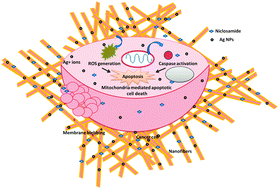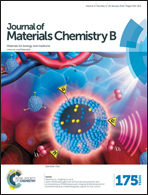Fabrication of electrospun poly(ethylene oxide)–poly(capro lactone) composite nanofibers for co-delivery of niclosamide and silver nanoparticles exhibits enhanced anti-cancer effects in vitro†
Abstract
An intrinsic property of many anticancer drugs including niclosamide is poor water solubility, which hindered their translation from laboratory to clinics. In an effort to enhance their water solubility and bioavailability, we have developed simplistic strategies based on the solvent evaporation and amorphous solid dispersion methods. Among various solvent evaporation methods, electrospinning was adopted in the present work. Poly(ethylene oxide) (PEO) was selected as the polymeric solid dispersion matrix of the drug based on various advantageous properties of PEO. Moreover PEO could also serve as a template for the in situ synthesis of silver nanoparticles (Ag NPs). Furthermore the co-delivery of multiple anticancer drugs within a nanocarrier is a promising approach to overcome the drug resistance and to achieve synergistic therapy. To achieve this goal, the drugs (niclosamide (nic)) and Ag NPs were loaded separately and together (nic@Ag NPs) into the nanofiber. The as-prepared various formulations of composite nanofibers were well-characterized by different techniques. The in vitro release and kinetic studies suggest the sustained release of niclosamide which followed Fickian diffusion kinetics. The anticancer potential of the drugs alone and the nic@Ag NPs loaded nanofibers were evaluated by MTT assay against A549 (lung carcinoma) and MCF-7 (breast carcinoma) cell lines. The co-delivery of anticancer drugs nic@Ag NPs from nanofibers displayed superior anticancer potential in vitro when compared to nic alone or Ag NPs composite nanofibers. Additionally nic@Ag NPs showed better therapeutic efficacy against MCF-7 cells. To confirm the mechanism of cell death by nic@Ag NP composite nanofibers on MCF-7 cells, various cell based assays were done. Our finding clearly explains that a combination of drugs with the diverse anticancer mechanism remarkably improved the therapeutic potential of drugs. Therefore, the nic@Ag NPs composite nanofiber as a co-delivery system might have potential applications in combination cancer therapy.


 Please wait while we load your content...
Please wait while we load your content...